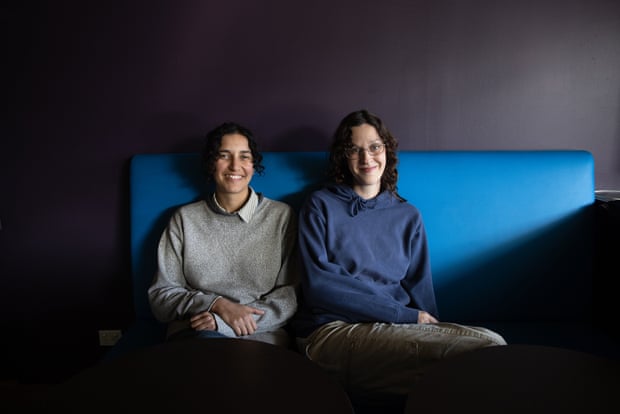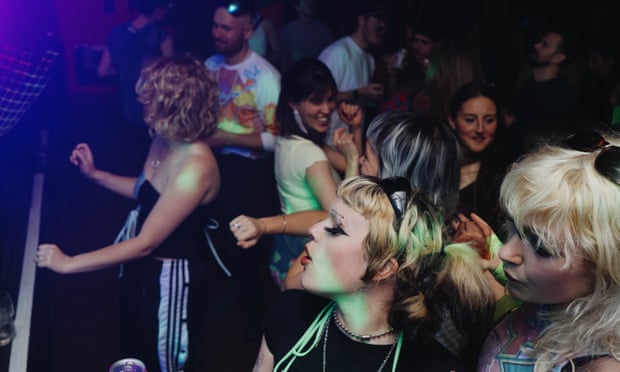In the middle of Sydney Road in Brunswick is an unassuming bar. The blinds are drawn across the windows, and scribbled on the door – so faint it would be easy to miss – is the word “queer”.
Inside, a crowd of she/hers and they/thems dressed in flannel, flares and silver chains are popping off. The vibe is pumping.
“I’ve never been to a space like this,” one non-binary reveller says. They have never been in a queer bar that doesn’t center around cis gay men, and which has more seats than strobe lights.
Another person in the bar, a 40-year-old lesbian, tells Guardian Australia that her brother was beaten up for “looking like a fag” just meters down the road in the 90s. She looks around and comments that times have changed.
This is Flippy’s, Melbourne’s newest LGBTAQI+ spot. It’s run by queers, for queers, and the crowd is appreciative.
LGBTAQI+ culture has changed. The acronym has gotten bigger and the word queer has been reclaimed to signify a more fluid, inclusive identity. Within the community gay bars can be controversial, often criticized for being sexist, transphobic and unwelcoming to people who aren’t cis gay men.

A new wave of queer bars are changing this – offering spaces that welcome trans, non-binary and non-white members of the community.
Flippy’s owners, Amy Parker and Em Lipschitz, say there was a shortage of queer spaces even before Covid, with some venues closing down.
“So for us, even then, we felt there was a need for the queer community to have a space that was, I guess, more fluid,” Parker says. “For a wider queer community, instead of a strictly gay or lesbian space.”
The space isn’t just a bar – they’re in the process of turning the back room into a gallery and have plans for the community to eventually own it.
“We’re starting to look at models for collective ownership and operation, which is our ultimate goal for Flippy’s,” Parker says.
‘everyone feels comfortable’
After two years of lockdowns, Australia’s queer venues and nights are finding a new lease on life.
“The queer scene in Naarm [Melbourne] is pumping now,” says Lipschitz. “I think that there’s a really nice point where lots of people are pretty comfortable, excited about their queerness.”
To get the bar off the ground, the pair taught themselves carpentry, got a mate to paint the place and found all the furniture secondhand.
“We definitely acquired a lot of skills along the way,” Lipschitz says. “I also know a strange amount of plumbing now.”
The response from the queer community has been overwhelming.

“Everyone feels comfortable,” Lipschitz says. “It leads to people expressing a lot of gratitude. I still get taken back when people are like: thank you, thank you.”
For queers, bars are not just places to get drunk; they are historically important spaces that act as the cornerstone of the community, and a safe place to find friends and chosen family, as well as lovers.
DJ Priya Vunaki and friend Diana Kalkoul started Nasty, a roaming queer dance party, in Hobart in 2021. They wanted a party with good music in an atmosphere that was femme and trans-inclusive.
“We aren’t capitalizing on a phenomenon or a queer market, we are making events for ourselves and our community,” Vunaki says. Nasty puts queer First Nations people on the door free and has a structured ticketing system, so the less money you have, the less you pay.
Tasmania’s only full-time gay bar, a venue called Flamingos in Hobart, closed last year.
“Queers just need a place to be their full selves, [to be] around like-minded people and to be seen properly,” Vunaki says.
“It’s sad that Hobart doesn’t have any gay or queer bars currently, and I think the community is suffering because of it.”
Sign up to receive the top stories from Guardian Australia every morning.
The new events are the spiritual successors to meet-ups held in the 1990s. Among the most revered was Pink Sofa, a monthly meet-and-greet for lesbians who had been chatting online. It began in 1997 and was held upstairs at Dante’s, a hip function space off Gertrude Street in Fitzroy.
It was hosted by publican Maria Frendo, a straight, married, cisgender woman whose queer-friendly events made her the quasi-matriarch of Melbourne’s lesbian scene from the 90s to 2000s.
“They used to have online chats, like the original chat room, and everyone was talking to each other but they couldn’t see each other,” Frendo says.
“So I said let’s have a get-together upstairs so you can finally see the person you’ve been talking to for hours.”
Frendio would fill her pub, The Glasshouse, with 400 lesbians, and employed an all-female crew of bouncers, bookers and promoters.

1997 was a crucial time in queer liberation. Tasmania decriminalized homosexuality, the last state in Australia to do so, but the broader culture was not accepting: the then-prime minister, John Howard, refused to offer a message of support to Sydney Gay and Lesbian Mardi Gras and said he would “be disappointed” if one of his kids was gay.
But by the late 2000s, the venues catering to queer women which had been established in the late 1990s had dropped away. Until the pandemic struck, bars and clubs that cater to cis gay men can still be found in every major capital city.
“It’s a hard market,” says Frendio. “Once the girls find a partner, they stop going out, and they didn’t have the disposable income like guys.”
Now Australia’s queer scene has entered a new era.
Kat Dopper has been running Heaps Gay, a queer party night in Sydney, since 2013, and is about to launch Summer Camp Festival, a one-day party in Melbourne and Sydney, later this year. She says post-lockdown queer events have just gotten bigger and bigger.

“I think the community realized the importance of safe spaces and our chosen families,” Dopper says.
“Nothing beats being on a dance floor with like-minded people you care about and trust. There’s this unspoken vibe – you can’t explain it.”
There’s another key element to the revitalization of the scene, however: mainstream acceptance.
“Queer is cool now,” Dopper says. “With the pink dollar, we’ve seen it with Pride, I’ve noticed it with Heaps Gay – they get more and more popular because queer is cool.”